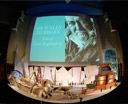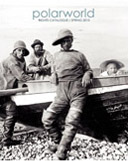Polarworld - discover more polar books
The Arctic Book Review
 Rogue Diamonds: Northern Riches on Dene Land
Rogue Diamonds: Northern Riches on Dene Land
Ellen Bielawski
Douglas & McIntyre, 2004
Reviewed by John David Hamilton
That wonderful Broadway star, Carol Channing, used to belt out "Diamonds are a girl’s best friend!" as if what she were saying was the most obvious thing in the world. That raucous song exemplified the whole $67 billion-a-year industry which cajoles every red blooded boy to put an expensive diamond ring on the left hand of his wife and an even more expensive one on the right hand of his mistress.
Today the inhabitants of Canada’s Northwest Territories are finding out whether it is true or not. They are neck deep in the greatest rush for precious stones since DeBeers was creating a world-wide empire in the late 19th century.
This is one of the most spectacular get-rich-quick rushes in history. What makes it different is that the aboriginal inhabitants are getting a share of the loot – white prospectors and their financial backers aren’t being allowed to totally despoil the land and leave with all the profits. Canadian diamonds are proudly advertised as "clean", in comparison with the "blood diamonds" from Sierra Leone or Angola. Two tribal groups of Indians (who call themselves "Dene" in the NWT) are starting to profit hugely in cash, jobs and education. But it is too soon to tell whether they will get very rich or will be ruined. The kimberlite "pipes" in the tundra may run out. Cheaper synthetic diamonds may replace natural ones. The investors may get cold feet in a recession and pull out.
Even so, the NWT diamond industry presents a quite different face from other rushes. The Yukon and Alaska both had major gold rushes and their populations became overwhelmingly white. But here, the population of the NWT is slightly more than half aboriginal -- mainly Dene and about one-eighth Inuit. All the diamond strikes have been made in territory claimed by two Dene tribal groups, the Dog Ribs and the Chipewyans.
What will the diamond strikes do to, or for, the indigenes? This is the worrying subject of a new book by Dr. Ellen Bielawski, director of the Native Studies Department of the University of Alberta in Edmonton. "Rogue Diamonds" is beautifully written and flows limpidly through its story of the negotiations she conducted for the Chipewyans with giant global diamond companies, and to a lesser extent with the rival Dog Ribs, the government of Canada and the government of the NWT.
Dr. Bielawski is a white woman born in Alaska and she first went to the Territories as a researcher for the Arctic Institute (Calgary, Alberta), and then stayed to work for the aboriginals living in the area east and south of Great Slave Lake. The Chipewyans and their neighbours and traditional rivals the Dog Ribs, have always lived in the boreal forest just west of the barren tundra, or Barren Lands, where they hunted caribou. Their traditional enemies were the Inuit who lived east and north of this area and the area became a kind of no man’s land. This is where today’s diamond mines are located.
Every paragraph of Dr. Bielawski’s her book shows her love of the land and her sympathy with its people and she brings the Barren Lands to vivid life. She is deeply concerned about what diamonds will do to this harsh and beautiful land and its indigenous inhabitants.
On this level "Rogue Diamonds" is a joy to read. Unfortunately, it is also confusing and badly needs a glossary to translate the names of native tribes and places into the English that has been traditional in the North for more than 200 years. She also leaves out essential background about the NWT which would help the reader understand what is happening now and what created the present situation. Finally, the only clearly defined personality in the book is Dr. Bielawkski herself and the reader gets no picture of the main figures among the natives, the politicians and the mining people. For instance, we learn nothing about the Sah'to Slavey leader, Stephen Kakfwi who fought hard and successfully for development of the mines with a substantial native share when he was premier of the NWT.
It is not surprising that Dr. Bielawski is biased in favour of the Chipewyans but she does them as well as other readers a disservice by not putting the situation into a context which clarifies today’s events. For instance, she takes no notice of how far the Dene came into the technological age even before diamonds were discovered in 1991. While she writes rhapsodically about the traditional values and lifestyle of the Dene, she takes for granted that they now travel by plane, pickup trucks, snowmobiles or aluminum skiffs with outboard motors; the hunters use high-powered rifles and every home has a pair of binoculars on the window sill to spot caribou. Some residents of her home village of Lutsel K’e (formerly Snowdrift) are sanitation trucks drivers, prospectors or mechanics; the modern community hall is electrically lit and cooled and some of the pre-fab houses have oil furnaces. The town has a nursing station and public school. All of these things have come into the NWT hinterland in the last half century through white government initiative and they have changed the traditional Dene out of the recognition of their ancestors.
Finally, Dr. Bielawski tends to speak of all the Indian tribes of the NWT as "Dene," as if they were a seamless union of people instead of territorial and linguistic groups with important tribal distinctions. The five disparate groups are Chipewyans, Dog Ribs, Decho, Sah’to and Gwi’chin. (This totally leaves out the Inuvialuit of the far north). Such distinctions are important elements in the present intense rivalry between the Chipewyans and the Dog Ribs over land claims and agreements on diamond mining.
Lutsel K’e is a small Chipewyan village at the extreme eastern tip of Great Slave Lake. Dr. Bielawski arrived in 1992 as an Arctic Institute researcher and soon began working for the local Dene, fighting for their all-too-vague rights and having to stickhandle among the international corporations, the Canadian federal government, the government of the NWT itself, and the neighboring Dog Rib Dene.
The main problems she faced had roots going back all the way to Canadian Confederation in 1867 and the federal government’s determination to open up the western prairies for European settlement without going to war with the indigenous natives as the Americans had. Starting in 1876, the government began negotiating treaties wherein the Indian tribes were persuaded to give up legal title to their lands in exchange for small sums of cash, a supply of weapons and tools and the vague promise of the benefits of civilization (as the whites saw it). Two treaties, 8 and 11, involved the people who lived north of the 60th parallel of latitude and the Barren Lands where no trees grew. The Indians and Eskimos of this gigantic territory were not affected by the land rush which followed the building of the transcontinental railroad and only a little by mining or lumbering Their main cash source was the fur trade which had been going on since the days of New France.
But after the Second World War, the petroleum industry started widespread explorations and began planning a 48-inch oil pipeline up the Mackenzie River. Young Indian leaders were demanding a new deal and the government was endeavouring to have native land claims settled once and for all. Just as the Yellowknife gold was petering out, huge diamond deposits were found in the Barren Lands.
It was at this stage that Dr. Bielawksi entered the scene and tried to get a good deal for the Chipewyans of Lutsel K’e. She was faced with the differences between the Chips and their neighbors and age-old rivals, the Dog Ribs, the government of Canada, the government of the NWT, and international giants like Rio Tinto (London) and Broken Hill Proprietory (Australia). Not only mines were proposed, but DeBeers was being challenged through processing plants for cutting and polishing the raw diamonds which were being built in Yellowknife. The government was willing to demand high payments, protective agreements and employment for aboriginals, but it stuck doggedly to its insistence that most native lands must become the legal possessions of Ottawa. In the case of the Inuit, who never had any treaties of any kind, the government handed over to them a vast chunk of the NWT and created the new territory of Nunavut.
In the 1970s, some far-sighted young men tried to unite the tribes and present a united front to Ottawa in the so-called Dene Nation. But it soon broke apart as the federal government practised a skilful divide and conquer policy. The Inuvialuit, who lived in the far northern NWT in the periphery of the mouth of the Mackenzie River, did not go with their cousins to Nunavut but were given land grants, cash and special political perks in the truncated NWT which was continued after Nunavut separated. Soon the Sah’tu and Gwi’chin made their own individual settlements with the government leaving the Decho, Chipewyans and stubborn Dog Ribs fighting for new deals under Treaty 8 (1899) or Treaty 11 (1922).
This was the situation when diamonds were discovered in the eastern NWT in 1991 and a new and more complicated game began. Only the Dog Ribs and the Chips were involved with the diamond mines. In one of the most moving parts of "Rogue Diamonds," Dr. Bielawski goes hunting with Chipewyan Chief Felix Lockworh and Council Member Frank Marlowe and the chief says bitterly: "Back when we were all one, the Dene Nation, we could all work together against the Feds; now, we’re split, it’s like the Feds just take us one at a time."
So, in spite of massive cash payments from the international financiers, hundreds of jobs in the mines and subsidiary industries, and agreements to protect the land and its resources, Dr. Bielawski is depressed. Her book does not mention that the raw diamonds are not the only huge cash cow – the international conglomerates are directly challenging the DeBeers Syndicate, which has traditionally made most of its profits through control of the cutting, polishing and marketing of diamonds around the world. Today, Yellowknife is bristling with new cutting and polishing factories and Tiffany’s in New York has agreed to market Canadian gems. Many Dene are employed in the factories and some Dene cash settlements have been invested in them. There is even a new school to train Dene in the jewellery finishing business.
Back to Arctic Book Review

 | join us
| join us  | home | contact
| home | contact



 Rogue Diamonds: Northern Riches on Dene Land
Rogue Diamonds: Northern Riches on Dene Land